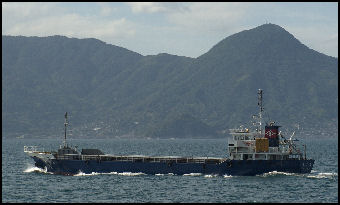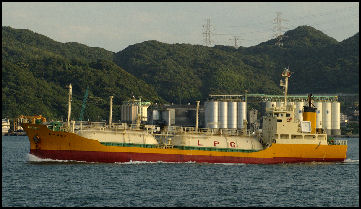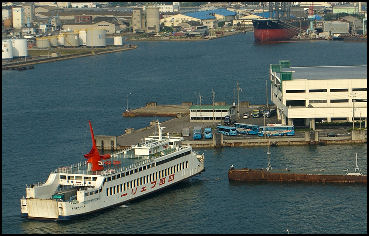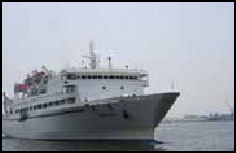SHIPPING AND BOAT TRAVEL IN JAPAN

coastal freighter In order to boost the competitiveness of ports in Japan, six ports (Tokyo, Yokohama, Nagoya, Yokkaichi, Osaka, and Kobe) were designated as “super-hub ports” in 2004. Efforts are being made to improve services and cut costs, while equipping the ports with container terminals and innovative logistics systems. Ports in Japan are also focusing on environmental measures, and 21 ports nationwide have been designated “recycle ports” with an aim to efficiently circulate recyclable resources using bulk transport ships that have a low impact on the environment. The designated ports have made it possible, in an integrated manner, to receive recycled materials, process them, and dispose of the residue. Nine ports in Japan, such as the Kagoshima and Beppu ports, have been equipped with passenger terminals to attract more international cruiseship lines. [Source: Web-Japan, Ministry of Foreign Affairs, Japan]
Most Japanese ships are crewed by foreigners. As of 2006, 86 percent of the crew on Japanese tankers and container ships were noon-Japanese. The number fo Japanese seamen has fallen from 50,000 in the 1970s to around 2,500 today. Each year the number shrinks as the number of Japanese seamen that retire far outweighs the number that are hired. The largest block of foreigners is made up of 28,000 Filipinos.
Freight handled by seaports in 2008 (number of containers): 1) Singapore (29.92 million); 2) Shanghai (27.98 million); 3) Hong Kong (24.25 million); 4) Shenzhen (21.41million); 5) Pusan (13.43 million); 24) Japanese (4.27 million); 29) Yokohama (3.49 million); 35) Nagoya (2.9 million); 44) Kobe (2.47 million).
Many Japanese ships are registered in Panama or Liberia.
Japan-operated ships have been targeted by pirates in the Malacca Strait but most the attacks have been foiled. They have also been targeted by terrorists in the Persian Gulf. See Terrorism and Piracy Under Asian Topics, Southeast Asia.
In October 2007 a man who fell off a tanker while taking a pee and survived a night in the open sea by clinging to a three-liter Pet bottle until a fishing boat rescued him the following day.
Shipbuilding, See Industry
Links in this Website: BICYCLES AND MOTORCYCLES IN JAPAN Factsanddetails.com/Japan ; URBAN TRANSPORTATION IN JAPAN Factsanddetails.com/Japan ; TRAINS IN JAPAN Factsanddetails.com/Japan ; SHINKANSEN (JAPANESE BULLET TRAINS) Factsanddetails.com/Japan ; AUTOMOBILES AND DRIVING IN JAPAN Factsanddetails.com/Japan ;AIR TRAVEL AND AIRLINES IN JAPAN Factsanddetails.com/Japan ; SHIPPING AND BOAT TRAVEL IN JAPAN Factsanddetails.com/Japan ; INFRASTRUCTURE AND PUBLIC WORKS IN JAPAN Factsanddetails.com/Japan
Good Websites and Sources on Transportation: Good Photos at Japan-Photo Archive japan-photo.de and japan-photo.de and japan-photo.de ; Ministry of Land, Infrastructure, Transport and Tourism mlit.go.jp ; Statistical Handbook of Japan Transport Chapter stat.go.jp/english/data/handbook ; 2010 Edition stat.go.jp/english/data/nenkan ; News stat.go.jp
Shipping Accidents in Japan

coastal LPG tanker There are may ships traveling in Japanese waters and accidents occur from time to time. In July 2003, a 3,372-ton Panamanian-flagged freighter collided with a 135-ton Japanese fishing boat. Seven of the 17 people on the fishing boat were killed. The accident occurred in at 2:25am while the Japanese boat was fishing with a group of other ships.
The Kanmon Strait between Kyushu and Honshu is regarded as one of the most dangerous waterways in the world because its narrowness and swift currents. About 70 collisions and other accidents occur there each year. See Military
The fishing boats sounded whistles and flashed lights as the freighter approached but the freighter didn’t slow down or change course and smashed into the fishing boat, which was unable to get out of the way because its engines were turned off because there was a net around the boat. The 17 men on the boat were thrown into the sea. It is believed that the crew on the freighter dozed off. A week later a South Korea vessel sank after it was rammed by a 499-ton patrol boat search for members of the fishing boat crew that were missing.
In October 2006, four ships ran aground in very rough seas off the Pacific coast of Japan during a fast-developing, typhoon-like storm, killing 33 people. Off the Izu Islands in Shizuoka Prefecture, a leisure fishing boat capsized, killing seven people. Eight people who clung to cooler boxes for safety were rescued. Off Miyagi Prefecture, a 198-ton saury fishing boat capsized after being pounded by high waves after it developed engine trouble, killing 16 people. Off Ibaraki Prefecture, a 98,587-ton cargo boat cargo ran aground, killing nine people. Off Iwate Prefecture, a bonito fishing boat became stranded. All 29 crew members were rescued.
In April 2007, a woman was killed and scores others when injured when a ferry traveling between Hakata, Japan and Pusan, South Korea, collided with a unidentified object, possibly a whale, 25 kilometers southeast of Pusan. Passengers said they herd a big bang before the ship rolled abruptly and the water turned red, possibly from whale blood.
In July 2005, a Malta-registered cargo ship sank after colliding with a Japanese freighter in dense fog in waters off of Chiba, leaving nine dead.
Shipping Accidents in Japan in 2008

docking ferry Collisions, See Government, Military; International, United States
In March 2008, three crew members were killed when a cargo ship loaded with gravel — the 496-ton Daihpo Eisei Maru’ship collided with a tanker — the 2,948-ton Ocean Phoenix — which in turn collided with another ship — the 1,466-ton Gold Leader, a Belize-registered cargo ship with 800 tons of steel and the three crew members who died — which sank.
All three ships were on autopilot and traveling in the same direction at the time of the accident in the busy Akashi Strait off Kobe. The tanker was warned by the coast guard but failed to respond. The crew of the tanker switched to manual when it noticed the gravel carrier approaching from the starboard but was unable to avoid being struck and then was unable to avoid hitting Gold leader.
The Gold Leader had a crew of nine Filipinos, all of whom were thrown into the sea by the collision. Six were rescued. One died. Two others were never found. No one on the other two ships died or was hurt. The taker was carrying 76 kiloliters of heavy fuel. Large amounts of oil leaked from the tanker, producing a 50-kilometer-long, 18-kilometer-wide slick damaging fishing and sea weed production in the area.
In April 2008, three died and 13 were missing after a Hong Kong freighter and Chinese fishing vessel collided in high seas south of Kyushu. The fishing boat quickly sank. Two of its crew members were rescued.
In March 2007, a 4,255-ton South-Korean-registered freighter sank in waters 120 kilometers off the Izu Oshima Island, about 120 kilometers south of central Tokyo, after colliding with a larger 10,833-ton freighter at 2:20am in misty seas. The 16-member crew’seven Koreans and nine Indonesians — on the South Korea ship went missing. No one on the other ship, which suffered a damaged bow, was hurt.
Shipping Accidents in Japan in 2008
In August 2009, a man who fell off the deck of an Okinawa-bound tanker was rescued in waters about 25 kilometers from Yorinjma, island in Kagoshima Prefecture. He was found clinging to a two-liter plastic bottle and he said he owed his life to that bottle.
In November 2009, four people died when a 29-ton South Korea fishing boat collided with a 3,843-ton Hong-Kong-registered freighter.
In November 2009, all 28 passengers and crew were rescued from a ferry boat — the 7,910-ton Ariake — that was turned on it side by heavy seas. Huge waves caused the cargo inside te ship to shift to one side and stay in that position until it ran aground. Pictures of the ship were quite dramatic.
In January 2010, a fishing boat carrying a crew of 10 capsized in high seas off the Goto Islands off Nagasaki.
FERRIES TO AND FROM JAPAN

Kobe-to-China ferry Check Randy’s “Favorite Getaways to Rural Japan Randy’s Ferries to Japan
Ferry Between Japan and Korea: There is a daily eight-hour ferry between Pusan, South Korea and Shimonoseki Japan (US$70-$140 one-way) as well as daily three-hour hydrofoils between Pusan and Hakata (US$85-$180 one-way). A ferry between Pusan and Kobe/Osaka (US$180-$260 one-way) operates in each direction twice a week.
A new ferry service between Kitakyushi, Japan and Pusan, South Korea was launched in June 2008. The previous service that operated between the places was terminated in 2004 because the operator went bankrupt. Websites:Japan Visitor, Seat 61 Korea Tourism
Ferry Between Japan and China: China-Japan ferries include one between Kaohsiung, China and Naha, Japan (US$150-$250 one-way), Shanghai to Kobe/Osaka/Yokohama (US$230-$570 one-way), and Tianjin, China to Kobe, Japan (US$290-$1500).
Two ships per week leave from Osaka Nanko for Shanghai. Economy class tickets for the 50 hour journey coast ¥20,000 one way and ¥30,000 round trip. Each weekly ship is operated by a different company. If you get a round trip ticket remember you have to take a ship from the same company both ways. For information in Japan call Shanghai Ferry (☎ 06-6243-6345) or Nitchu Kokusai Ferry (06-6536-6541). Websites: Seat 61 ; typepad.com ; Lonely Planet Thorntree
Ferry Between Japan and Russia: Flights between Vladivostok, Russia and Niigata, Japan cost about US$1,000 round trip. Boats to Vladivostok leave from Niigata on the second and third Fridays in June and from Fushika on the last Friday in June and first Friday in July. This pattern of alternating ports every two weeks is repeated until Oct 21. Trip takes 40 hours and cost between US$280 and US$730. Return Boats leave Vladivostok on Tuesday. For more information contact Jiero Travel Agent Kta Shijo Nishi, 7-1-5 Chuo-ku, Sappori-shi, Hokkaido, Japan ☎ (8111-281-0216, fax (8811) 281-0201.
From late April to early September, ferries operate between Otaru on Hokkaido and Kholmsk on Russia's Sakhalin Island and between Wakkanai on Hokkaido and Korsakov on Sakhalin Island. There are cruise boat services between Yokohama and Vladivostok. Some tourists use this system to link up with the Trans Siberian Railway.
The ferry between Toyama, Japan and Vladivostok, Russia is very expensive, with prices ranging between $300 and $550 for a berth. The ferries leave Japan on Wednesday and Friday at 4:00pm and arrive after two nights at 9:00am. The schedule can be disputed by bad weather. Website: Website: Seat 61; ; Way to Russia
Taiwan: There used to be a weekly ferry between Naha, Okinawa with Kaohsiung run by Arimura Shangyo but this was discontinued in June 2008 Taiwan.
North Korea: North Korea's only link to a non-Communist country is via the Mangyoungbong-92, a 400-foot, 300-passenger ferry boat that travels between Wonsan, North Korea and Niigata, Japan three times a month.
The vessel is mainly set-up for Korean residents of Japan traveling to North Korea, who are supposed to bring with them high-tech items such as computers or large amounts of foreign currency which is badly needed in North Korea to purchase foreign goods. The glistening white ship was built by Korean residents of Japan who are loyal to Pyongyang.
Most of the passengers are elderly ethnic Koreans visiting their families or graves of their ancestors or students on field trips organized by schools in Japan affiliated with North Korea. It is for all intents and purposes impossible for a non-North Korean or non-Japanese-North Korean to take this ferry
See Economic, Agriculture, Fishing, Fishing
Image Sources: Ray Kinnane
Text Sources: New York Times, Washington Post, Los Angeles Times, Daily Yomiuri, Times of London, Japan National Tourist Organization (JNTO), National Geographic, The New Yorker, Time, Newsweek, Reuters, AP, Lonely Planet Guides, Compton’s Encyclopedia and various books and other publications.
Last updated March 2012
